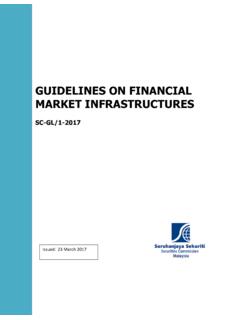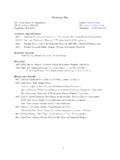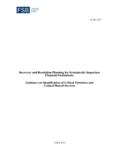Transcription of ACRITICALREVIEWOFMOBILEPAYMENTRESEARCH
1 A CRITICAL REVIEW OF MOBILE PAYMENT RESEARCH 2 1,2 3, *. Tomi Dahlberg , Jie Guo and Jan Ondrus 1 School of Finance and Economics, Xi'an Jiaotong University, China 2 bo Akademi University (IAMSR), Finland 3 ESSEC Business School, France Email: _____. ABSTRACT This article aims at assessing the progress of mobile payment research over the last 8 years. A previous literature review (Dahlberg et al. 2008b), covering articles published between 1999 and 2006, showed that the majority of research had only focused on a few topics. In order to address this issue, a research agenda was formulated to encourage researchers to explore new topics. Almost a decade later, our review reveals that researchers have continued to focus on the same topics (especially consumer adoption and technology aspects) with a limited accumulation of new knowledge and similar findings.
2 In addition to reviewing the literature, we discuss the possible reasons for the lack of research diversity and propose new recommendations to enhance future mobile payment research. Keywords: mobile payments, literature review _____. * Corresponding author. Tel. +33 1 34 43 36 73, (Jan Ondrus) This paper has been published in: Electronic Commerce Research and Applications. To find the proper citation: 1 1. INTRODUCTION Mobile payment research started soon after the first payment transaction was conducted with a mobile device in 1997. In Finland, Coca Cola experimented with vending machines that accepted SMS payments. After a decade of research, a literature review written by Dahlberg et al. (2008b) was published in the Electronic Commerce Research and Applications journal.
3 The review reflected the authors' cumulative understanding of mobile payments, which they had independently investigated in several countries and continents for several years. After producing a fair part of the literature on this topic themselves, the authors felt that there was a need to provide guidance for future research. Their main motivation was that mobile payment issues were not fully explored by the academic community. In fact, a considerable number of the publications focused mainly on two issues: technology and consumer adoption. Interestingly, at the time, few consumers were able to experience mobile payments. And a great number of mobile payment initiatives failed before they even reached their intended end- users. Due to the complexity of the phenomenon, it was clear that the investigation of consumer adoption in isolation would only provide a limited understanding of mobile payments.
4 In their article, Dahlberg et al. (2008b, p. 165) also proposed a definition for mobile payments to clarify the concept, which had been subject to different interpretations. Mobile payments were defined as "payments for goods, services, and bills with a mobile device by taking advantage of wireless and other communication technologies". Furthermore, they stated that "a mobile payment is carried out with a mobile payment instrument such a mobile credit card or a mobile wallet". Mobile payments were thus distinguished from any specific type of electronic or mobile money, the use of mobile devices to access electronic payment services, and electronic banking (unless there was a separate mobile payment instrument , or an account reserved for mobile payments).
5 With this definition in mind, Dahlberg et al. (2008b) also crafted a multi- dimensional framework to describe mobile payment markets (and the literature). Their framework consisted mainly of two parts: i) the mobile payment service market based on Porter's Five- Forces model, and ii) the contingent factors impacting markets based on general contingency theory. Today, the accumulation of articles on mobile payments published after 2006 motivates a new critical review of the literature. We performed a systematic literature search and identified 188 articles published during the last eight years (2007- 2014), of which 87 were in major conferences or in journals with an impact factor greater than After carefully reading the recent articles, we found that researchers have often been re.
6 Inventing the wheel . Several studies showed by 2006 that "security" and "trust" are important pre- requisites for the adoption and use of mobile payments. In more recent literature, the same findings were put forward as principal theoretical contributions, which awarded publication in respectable outlets. We admit that confirming earlier findings could be sometimes justified. Yet, this practice led us to wonder why past research findings were ignored. 2 Dahlberg et al. (2008b) outlined 22 research proposals for future research. Interestingly, their well- cited article has had limited impact on the kind of research that has been conducted after its publication. Overly- researched topics have continued to attract researchers. In 2008, Dahlberg et al.
7 (2008b) already considered that there is little need for additional studies on consumer adoption of mobile payments ( , with TAM and UTAUT models), especially since we knew and still know so little about merchant adoption. Yet, consumer adoption (based on the mentioned models) has remained one of the most investigated research topics, providing few new insights. But why is there so much eagerness to conduct consumer adoption studies for mobile payments? We speculate that empirical data from consumers on their attitude and intentions could be easier and more convenient to collect. Another reason may be that journals are still keen to accept such studies, even though the relevance and the contributions are clearly limited. If these reasons can be confirmed, we are curious to know what signals this practice sends to the industry and the academic communities.
8 Overall, we fear that the limited progress made over the years has created a gap between practice and academia. The purpose of this article is to critically analyze mobile payment research carried out after the publication of the previous literature review (Dahlberg et al. 2008b). We aim at comparing the volume, research methods, research themes, and other statistics about mobile payment research between the two periods (1998- 2006 versus 2007- 2014). We also examine which recommendations of the previous literature review have impacted mobile payment research. In order to improve future mobile payment research, we also provide an updated list of recommendations. As a whole, our article aims at answering the following two research questions: Why have we seen limited progress in several mobile payment research themes during the last eight years?
9 What should researchers do in order to improve their research on mobile payments? To address the first research question, we present in Section 2 the methodology of the literature review and compare the statistics between the two periods studied. In Section 3, we review and comment on the progress of the three dominant themes of mobile payment research: strategy and ecosystems, technology, and adoption. In Section 4, we provide critical comments and recommendations for future research. We conclude in Section 5. 2. LITERATURE REVIEWS THAT WERE CONDUCTED Since Dahlberg et al. (2008b), several literature reviews about mobile payments have been written. In 2013, Slade et al. (2013) exclusively reviewed mobile payment adoption papers. More recently, Dennehy and Sammon (2015) reviewed the 20 mobile payment articles most cited in Google Scholar.
10 Moreover, de Albuquerque et al. (2014) performed an exhaustive review by including articles addressing mobile payment issues in developing countries. We believe that mixing articles focusing on developing and developed markets could cause confusion about the progress of mobile payment research. In fact, mobile payment services from developing markets are unlikely to penetrate developed economies with their advanced financial markets and sophisticated telecom, merchant and consumer 3 infrastructures. Consequently, we prefer to avoid the inclusion of both type of markets into our review and solely focus on developed economies. While the three above- mentioned reviews have their own merits, there is still a need to perform an inclusive literature review and provide recommendations for future research on developed countries.







